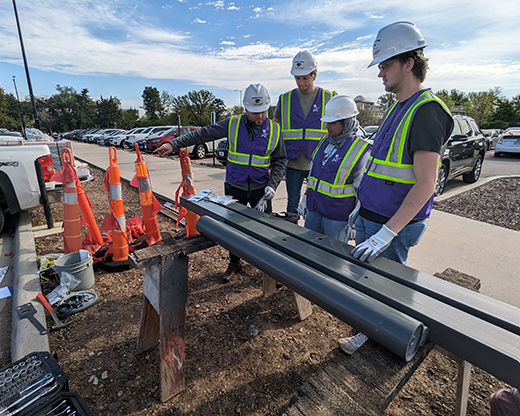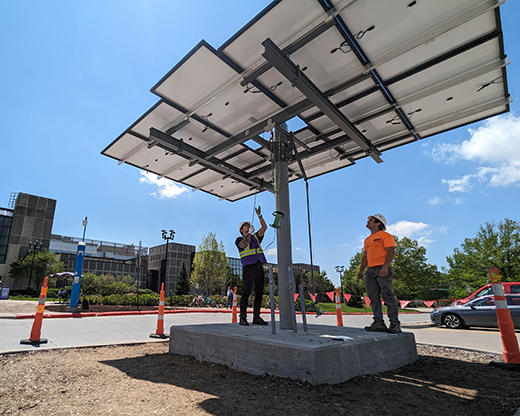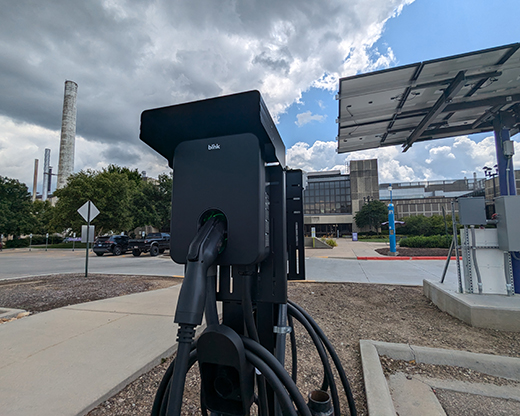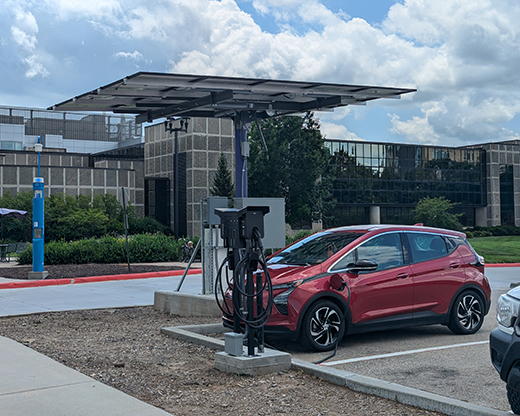K-State has a new spot to power up electric cars, and engineering students led the charge
Monday, July 22, 2024
MANHATTAN — Sure, Matt Bachman will be excited to see his old professors and friends when he returns to Kansas State University in a few years, now as a graduate of the university's Carl R. Ice College of Engineering.
But the recent construction science and management graduate will be particularly keen on seeing if anyone is using the electric vehicle charging station he helped get built on campus.
As part of an undergraduate research project, Bachman and several other K-State students from the past few graduating classes of the GE Johnson Department of Architectural Engineering and Construction Science have been working on a design for a cost-efficient, scalable and replicable campus EV charging station.
Following years of work, the students' solar canopy design was finally installed in the engineering parking lot late this spring, with final charging station installation completed last week.

Derek Clements, assistant professor of architectural engineering and construction science, overlooks engineering plans with a group of students as they install the metal column and base for a solar-powered, off-grid EV charging station in parking lot A28, also known as the engineering parking lot. | Download this photo.
It's been hands-on, applied learning at its best, said Derek Clements. He and Shannon Casebeer — assistant and associate professors of architectural engineering and construction science, respectively — have helped manage the student researchers' work over the years.
"It's been an iterative process, with students in electrical and structural engineering and construction management working together," he said. "They came up with an electrical design, talked through the structural requirements to support that design and then worked through the construction science to determine pricing, budgeting and scheduling for the project.
"These kinds of applied learning experiences mimic what gets done in the real world — on a much smaller scale, of course, but very much with the same conversations and collaborations that take place with these kinds of projects," Clements continued.
Showcasing student researchers' work
The project began when Clements first arrived at K-State seven years ago, along with about $6,000 in startup research funds.
When he got his first EV, he noticed there were relatively few chargers both around campus and around Manhattan, so he decided to use some of that funding to pay undergraduate researchers to develop a prototype for an off-grid charging station.
"We bought a handful of panels, all of the electrical components," Clements said. "This was right around the beginning of COVID, and we didn't have as much space on campus, so we built the prototype in my garage."

Gibson Yu, a spring 2024 graduate in architectural engineering, helps workers with BHS Construction hoist a solar panel array atop a metal column in late April 2024. | Download this photo.
In thinking of potential locations for the station on campus, the students initially thought they'd be lucky to get the university's facilities division to sign off. Any spot with sunlight would do.
But the students were underestimating themselves and the enthusiasm behind their project.
"As soon as most people around campus heard about this project, they became excited," Clements said. "Everyone we talked to wanted to make sure we were showcasing this work as much as possible."
The project was eventually given the first two spots in parking lot A28, commonly known as the engineering parking lot, just north of the Engineering Complex.
EV charging station project is K-State applied learning
Even with a prototype, the students learned that in the real world, engineering and construction is a time intensive, iterative process.
First, they realized they would need to scrap their original prototype — a cantilever design that would have also provided shade over two parking stalls — because while sturdy, it would have ended up costing too much. The solar panels would also not be as efficient, at least at that structure's price point.
They eventually settled on a much simpler, but cheaper and more cost effective, design that more or less boiled down to mounting a smaller canopy over a pole.

The newly installed EV chargers are free to use, although standard K-State parking rules apply. Users must have a valid campus parking permit to park in the stalls 8 a.m. to 5 p.m. Monday through Friday, and license plates must face the drive aisle. | Download this photo.
Much of that final structural design work was completed last fall by Marissa Ober, spring 2024 master's in architectural engineering graduate, Alden.
She had to analyze the geotechnical reports for the selected site and design a structure, foundation, base plate and column for a solar canopy that could withstand both the weight of the equipment and the potential wind uplift from such a big area of solar panels.
It was difficult, but educational, work, she said.
"The best part is we had an electrical student, and we also had construction science majors come in on it, too," she said. "It was like a full discipline situation. We all got to work with each other, and it was like a mini design office within undergraduate research, and that was really fun."
Students' EV charging station design meant to be replicable
Through the support of a National Council of Examiners for Engineering and Surveying Education grant, funding from the Carl R. Ice College of Engineering, and additional in-kind donations from HME, Inc., the students were able to complete the project for about $40,000, including materials, supplies and installation.
That's more expensive than EV chargers connected to the power grid, but significantly cheaper than similar, commercially available off-grid charging stations, Clements said.
At that price, the project has continued to gain interest from others in the university and Manhattan community to potentially replicate elsewhere.
"Initially, we thought this might be a thing where a handful of people would be able to benefit from these stations," he said. "But the growth over the past five years has been so tremendous that now we're thinking, maybe two stations isn't enough anymore."

Drawing its power from the sun, the student-designed, off-grid EV charging station has a limited battery capacity to provide minimal range at night or during extended overcast conditions. If the station batteries are depleted and the sun is not shining, the charging stations are not able to charge EVs. | Download this photo.
Bachman, the spring 2024 graduate in construction science and management, Wichita, was the project's estimator and a key contributor in developing a cost-efficient design. He worked with the rest of the students to plan the budget for the project and give input on areas where it could be more cost-effective.
"It's one thing to go to class and work through hypotheticals or memorizing things, but actually being able to do what I'm already going to be doing in the real world in a few months is super rewarding," Bachman said.
While he graduated before the charging station was complete, Bachman said he is excited that he and his fellow students were able to leave a mark on campus through their applied learning experiences.
"For most of my time on the project, it was mostly on-paper work, but getting to see it go up the last few weeks (of my undergraduate career) has been super cool," he said. "To see it and be like, 'Wow, I got to work on that, and every single student who comes to K-State will see it and see my work.'"
